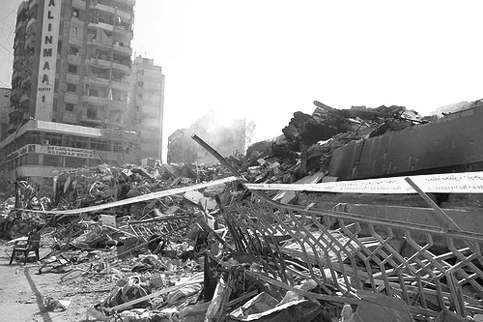- By Nafez Zouk, The Daily Star, Friday, July 27, 2007

- Photo: Dahiyeh, August 2006. Voices in the Wilderness
BEIRUT: An empty lot in Dahiyeh, Beirut’s southern suburbs and a Hizbullah stronghold, has been converted into an open-air exhibition in remembrance of last summer’s war with Israel.
Spider Web, as the exhibit is titled, serves as a stark reminder of the scale of death, destruction and the breadth of military engagement of the conflict.
“The idea behind this project was conceived by a group of artists and media people in commemoration of the war last summer. The exhibition embodies a panoramic story of the war told in an artistic way,” says Ali Daher, who supervised the project.
The exhibit, produced by Hizbullah’s Department of Media Events, is open daily from 10 a.m. to 10 p.m. and runs until September 10.
The 5,000-square-meter lot has been transformed into a military landscape, with high walls and barbed wire enclosing military hardware belonging to Hizbullah and the Israeli Army.
A giant Soviet-era T-54 tank – which a placard says was “looted by the Resistance in May 2000” – is partly buried in the ground at the entrance of the exhibition, with its canon muzzle pointing at the visitor. A few steps away, a destroyed personnel carrier lies half-burned and entrenched in the sand and stones. Children climb on top of both machines to play. Towering above are two rocket launchers aimed at the sky.
An olive-green sign marked Entrance points to a cave dug into the rocks. A dark tunnel of hundreds of sandbags leads into the cave. “This is a re-creation of the command center used by the fighters at the front lines,” says a guide standing in what looks like a fully equipped military barracks.
“Here is where the fighters would come to rest and plan their operations,” says the tour guide, pointing to a dark room strewn with military uniforms, helmets, boots and combat rifles. A large, detailed map of South Lebanon hangs on a wall amid many Hizbullah flags and posters of Hizbullah leader Sayyed Hassan Nasrallah. Scattered across the tables are desktop and laptop computers, walkie-talkies and telephones.
The sandbag-lined tunnel leads into a more spacious room lined with posters and images recalling some of the major political and humanitarian events of the war.
“We wanted to shed some light on a variety of issues that were important during the war, that are still in people’s memories and that people would appreciate,” Daher told The Daily Star.
Some photos depict Israeli girls signing Israeli bombs before they were fired into Lebanon. “This is their culture, this is their belief,” reads the caption.
Another post deals with cluster bombs and documents the scope of their destruction in a series of graphic images.
One corner is dedicated to reliving Hizbullah’s sinking of an Israeli naval vessel off the Lebanese coast just south of the capital. “Watch it burn – we will sink it with dozens of Israeli Zionist soldiers,” says an excerpt from the speech Nasrallah read as the vessel was being attacked.
Scattered on the floor are cases containing an array of highly sophisticated weaponry ranging from video cameras and night-vision goggles to American- and Soviet-made assault rifles, bombs with Hebrew markings, helmets and Israeli uniforms, as well as ammunition and rocket remains.
To accentuate the ubiquitous aura of military glory, standing in the middle of the room are the charred remains of what a sign identifies as an Israeli CH-53 Sea Stallion helicopter.
A few steps away, a video promoting the new release of the second version of Hizbullah’s video game is playing on a TV screen. Enhanced graphics explain how to win the game: destroy the Israeli enemy.
Another segment of the exhibition is dedicated to the victims of the conflict and to the death and wounds that the fighting produced. The walls of one room are lined with pictures of dead and wounded babies, and the floor is covered with rocket remains scattered around an empty baby cradle.
“We won, Lebanon won, Palestine triumphed and so has the Arab nation as a whole. All the vulnerable, oppressed, deprived and victims in this world have triumphed,” reads a nearby quote made by Nasrallah after the war ended.
The final phase of the exhibition is a light and sound spectacle so overwhelming as to make the visitor feel the atmosphere of a war zone.
Explosions, tanks, screams and cries blare from speakers amid images of attacks on the Israeli Army and towns. A destroyed Merkava tank lies deep in a hole, smoke rising from the tank and Israeli soldiers either dead or trying to flee.
The exit from the exhibit, lined on either side with tank treads, is decked with destroyed tanks and helicopters.
A quiet, green garden, its serenity a striking contrast to the roughness of the surrounding military landscape, stands in the corner of the lot. The placard dubs it Martyr’s Oasis, as a white staircase protruding from the grass leads up to a white door, beyond which is only sky.


